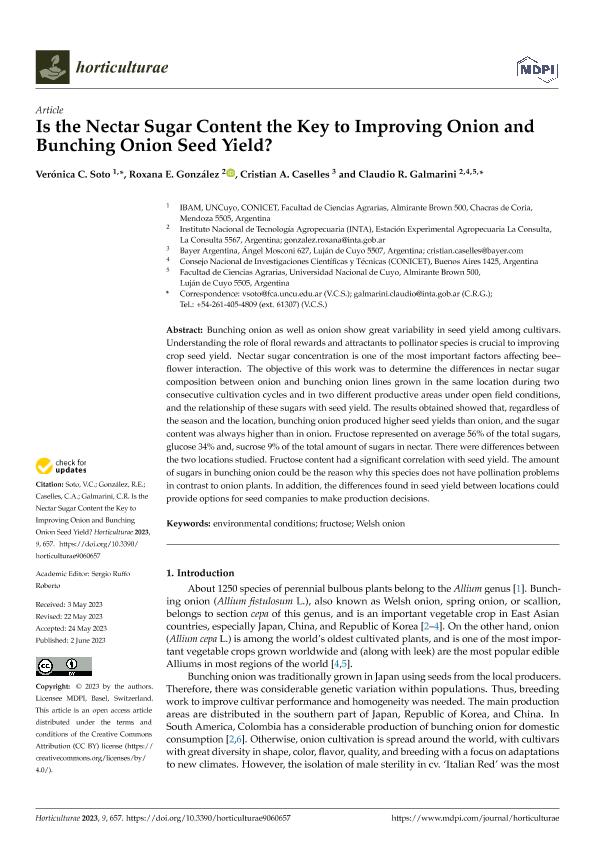Mostrar el registro sencillo del ítem
dc.contributor.author
Soto Vargas, Verónica Carolina

dc.contributor.author
González, Roxana Elizabeth

dc.contributor.author
Caselles, Cristian A.
dc.contributor.author
Galmarini, Claudio Romulo

dc.date.available
2024-01-03T14:43:05Z
dc.date.issued
2023-06
dc.identifier.citation
Soto Vargas, Verónica Carolina; González, Roxana Elizabeth; Caselles, Cristian A.; Galmarini, Claudio Romulo; Is the Nectar Sugar Content the Key to Improving Onion and Bunching Onion Seed Yield?; MDPI; Horticulturae; 9; 6; 6-2023; 1-9
dc.identifier.issn
2311-7524
dc.identifier.uri
http://hdl.handle.net/11336/222251
dc.description.abstract
Bunching onion as well as onion show great variability in seed yield among cultivars. Understanding the role of floral rewards and attractants to pollinator species is crucial to improving crop seed yield. Nectar sugar concentration is one of the most important factors affecting bee–flower interaction. The objective of this work was to determine the differences in nectar sugar composition between onion and bunching onion lines grown in the same location during two consecutive cultivation cycles and in two different productive areas under open field conditions, and the relationship of these sugars with seed yield. The results obtained showed that, regardless of the season and the location, bunching onion produced higher seed yields than onion, and the sugar content was always higher than in onion. Fructose represented on average 56% of the total sugars, glucose 34% and, sucrose 9% of the total amount of sugars in nectar. There were differences between the two locations studied. Fructose content had a significant correlation with seed yield. The amount of sugars in bunching onion could be the reason why this species does not have pollination problems in contrast to onion plants. In addition, the differences found in seed yield between locations could provide options for seed companies to make production decisions.
dc.format
application/pdf
dc.language.iso
eng
dc.publisher
MDPI
dc.rights
info:eu-repo/semantics/openAccess
dc.rights.uri
https://creativecommons.org/licenses/by/2.5/ar/
dc.subject
ENVIRONMENTAL CONDITIONS
dc.subject
FRUCTOSE
dc.subject
WELSH ONION
dc.subject.classification
Horticultura, Viticultura

dc.subject.classification
Agricultura, Silvicultura y Pesca

dc.subject.classification
CIENCIAS AGRÍCOLAS

dc.title
Is the Nectar Sugar Content the Key to Improving Onion and Bunching Onion Seed Yield?
dc.type
info:eu-repo/semantics/article
dc.type
info:ar-repo/semantics/artículo
dc.type
info:eu-repo/semantics/publishedVersion
dc.date.updated
2024-01-03T12:32:39Z
dc.journal.volume
9
dc.journal.number
6
dc.journal.pagination
1-9
dc.journal.pais
Suiza

dc.journal.ciudad
Basilea
dc.description.fil
Fil: Soto Vargas, Verónica Carolina. Consejo Nacional de Investigaciones Científicas y Técnicas. Centro Científico Tecnológico Conicet - Mendoza. Instituto de Biología Agrícola de Mendoza. Universidad Nacional de Cuyo. Facultad de Ciencias Agrarias. Instituto de Biología Agrícola de Mendoza; Argentina
dc.description.fil
Fil: González, Roxana Elizabeth. Instituto Nacional de Tecnología Agropecuaria. Centro Regional Mendoza-San Juan. Estación Experimental Agropecuaria La Consulta; Argentina. Consejo Nacional de Investigaciones Científicas y Técnicas. Centro Científico Tecnológico Conicet - Mendoza; Argentina
dc.description.fil
Fil: Caselles, Cristian A.. No especifíca;
dc.description.fil
Fil: Galmarini, Claudio Romulo. Instituto Nacional de Tecnología Agropecuaria. Centro Regional Mendoza-San Juan. Estación Experimental Agropecuaria La Consulta; Argentina. Consejo Nacional de Investigaciones Científicas y Técnicas. Centro Científico Tecnológico Conicet - Mendoza; Argentina
dc.journal.title
Horticulturae
dc.relation.alternativeid
info:eu-repo/semantics/altIdentifier/doi/https://doi.org/10.3390/horticulturae9060657
Archivos asociados
